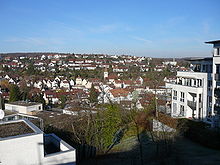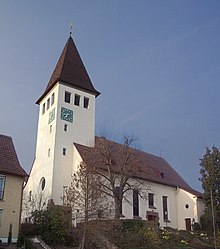Botnang
|
Botnang City district of the state capital Stuttgart |
|||||||||||||||||||||||||||
|---|---|---|---|---|---|---|---|---|---|---|---|---|---|---|---|---|---|---|---|---|---|---|---|---|---|---|---|
| District coat of arms | City map | ||||||||||||||||||||||||||

|
|||||||||||||||||||||||||||
| List of districts of Stuttgart | |||||||||||||||||||||||||||
| Incorporation : | April 1, 1922 | ||||||||||||||||||||||||||
| Height : | 357 m above sea level NHN | ||||||||||||||||||||||||||
| Population density : | 6,166 inhabitants per km² | ||||||||||||||||||||||||||
| Postal code : | 70195 | ||||||||||||||||||||||||||
| Area code : | 0711 | ||||||||||||||||||||||||||
| Address of the district town hall: |
Klinglerstrasse 7 70195 Stuttgart |
||||||||||||||||||||||||||
| Website: | www.stuttgart.de | ||||||||||||||||||||||||||
| District Head: | Mina Smakaj | ||||||||||||||||||||||||||
|
|||||||||||||||||||||||||||
| Transport links | |||||||||||||||||||||||||||
| Light rail | U 2 U 29 | ||||||||||||||||||||||||||
| bus | 91, N2 | ||||||||||||||||||||||||||
| Source: Stuttgart data compass | |||||||||||||||||||||||||||
Coordinates: 48 ° 47 ' N , 9 ° 8' E
Botnang (formerly also Bothnang) is a district of Stuttgart and is located between the districts of Kräherwald and Wildpark of Stuttgart-West and the Feuerbacher Valley of Feuerbach , around 3 km west of the city center .
geography
Botnang is almost completely surrounded by forest. The district is at 316 m above sea level. NN up to 479 m above sea level NN (at the so-called forester's house ). The water around Botnang is collected in the north by the Knaupenbach, in the east by the Metzgerbach, which merge below Botnang to form the Feuerbach . The Buberlesbach , which runs partly underground and comes out of the Buberlesweiher in the west , also runs through Botnang .
coat of arms
Description of the coat of arms : The Botnang coat of arms shows a boar between two deciduous trees (which are interpreted as beeches) and was created in 1919 after the processing of a community chronicle found that there was previously neither a coat of arms nor any other symbol for Botnang. The motif proposed by the Stuttgart archive management refers to the wild boar park, which was created by King Friedrich in 1815/16. Since the incorporation in 1922, the coat of arms is no longer an official emblem, but is still traditionally used a lot.
The real landmark of Botnang is the cuckoo ( local name ). According to a legend, the Duke of Württemberg asked the Botnang to buy him the "home of the cuckoo". As a result, the Botnang had to give him the entire forest.
history
In the Roman era about 1900 years ago, two important Roman traffic routes crossed in the area of today's forester's house on Oberen Kirchhaldenweg. Already at this time there was a pottery settlement on the east side of the Feuerbach.
Botnang emerged as an extension from Feuerbach and was first mentioned in a document in 1075 in the form of Botenanch . The name is traced back to the connection of the personal name Bodo with Wang (e) = slightly arched or inclined meadow or corridor. In 1075, the landlords at that time, the Counts of Calw , transferred their property and the proceeds from Botnang to the Hirsau Monastery . In 1281 Hirsau sold his Botnang properties to the Bebenhausen monastery , and since 1356 a distinction has been made between Ober- and Unterbotnang. In 1481, Botnang was acquired by Duke Eberhard im Bart and thus part of Württemberg. At that time the brothers Conrad and Bernhard Schenk von Winterstetten were named as selling hereditary owners of half of the hamlet , as well as Martin and Eberhardt von Heusenstamm together with their uncle Eucharius von Venningen , the latter their father and grandfather Johann von Venningen , an Electoral Palatinate Vitztum in Neustadt the Weinstrasse had bequeathed this partial property from the inheritance of his wife Adelheid von Frauenberg .
The Thirty Years War brought misery and devastation to Botnang as well. If there were still 645 inhabitants together with Heslach in 1621, these were decimated to 210 inhabitants by 1643.
In 1765, Duke Carl Eugen built Solitude Palace in the immediate vicinity of Botnang . Many of the craftsmen for this purpose were quartered in Botnang. To this day there are close ties between Solitude, which is part of the Stuttgart-West district, and Botnang.
Until the beginning of industrialization , the place was known as the village of the washer-men and bleachers , as it was well supplied with wood and water due to its geographical location, and it worked for all of Stuttgart. In addition, agriculture and viticulture formed the economic focus of the place.
After the increasing industrialization of Stuttgart, Botnang gradually turned into a workers' settlement. On April 1, 1922, Botnang was incorporated into the city of Stuttgart . At that time (1925) Botnang had 4579 inhabitants, today the district has more than 13,000 inhabitants.
religion
Until the 15th century Botnang belonged to the parish of Feuerbach . In 1483 it was separated and received its own parish. The place was reformed around 1530, and the oldest surviving baptismal register dates from 1558 .
Incorporation

The place belonged to Feuerbach ecclesiastically until 1483 and politically until 1631. On April 1, 1922 Botnang was incorporated into the city of Stuttgart.
The Solitude Palace , which until 1942 belonged to the municipality (today the city) of Gerlingen , was incorporated into Stuttgart on April 1, 1942 and assigned to the Botnang district.
When the city of Stuttgart was divided into districts in 1956, the Solitude residential area was assigned to the newly established Stuttgart-West district and Botnang was declared an independent district. When the Stuttgart districts were reorganized on January 1, 2009, the Botnang district was divided into four districts: Botnang-West, Botnang-North, Botnang-South and Botnang-East. Botnang thus consists of four districts .
Economy and Infrastructure
traffic
Botnang is close to the L 1187 / Wildparkstraße, the connection from Stuttgart to Leonberg. Wildparkstraße is an important feeder road to the A 81 and A 8 motorways . Local public transport is served by the Stuttgart trams .
- U 2 Neugereut-Bad Cannstatt- Stöckach -Charlottenplatz-Rotebühlplatz- Vogelsang - Botnang
-
U 29 Hauptbahnhof- Vogelsang (- Botnang)
during school holidays and outside rush hour only between the main station and Vogelsang - 91 Sindelfingen / Lauchhau - Vaihingen / (University) - Botnang - Feuerbach
- N2 night bus Schlossplatz - Botnang - Schlossplatz (Fri / Sat / Sun night)
Schools in Botnang
Elementary schools
- Franz Schubert School
- Kirchhaldenschule
further training
- Protestant college for social education
Culture and sights
Buildings
- The Church of the Resurrection in Eltinger Straße characterizes the cityscape of the "old Botnang". It can often be found as a motif on pictures and postcards. The church was rebuilt after the Second World War on the ruins of the old village church.
Regular events
- The street festival organized by the ARGE Botnang's member associations on the last Saturday before the summer holidays in the Marktplatz / Griegstraße / Franz-Schubert-Straße area.
- The ARGE also organizes the Christmas market on the Saturday before the 1st of Advent. Until 2005, this always took place on Alte Stuttgarter Straße. In 2006 the Christmas market moved to Griegstrasse.
- The lantern parade in mid-October attracts over 800 participants every year. In two trains you go through the colorfully decorated streets of Botnang to the green area in front of the ball sports hall to the big final fire.
- Every Wednesday the "Wednesday Afternoon" takes place in the community center Botnang at 2:30 pm . It is organized by the Arbeiterwohlfahrt, the Protestant and Catholic churches, and the Botnang community center. It is aimed primarily at the older residents of Botnang, but is open to anyone interested. Wednesday afternoons have been taking place regularly since the late 1970s.
- There are also events in the Botnang youth and children's club, as well as in the Protestant youth club Level 19.
politics
Due to the number of inhabitants in the district, the Botnang District Advisory Board has 12 full and just as many deputy members. The following distribution of seats has been in effect since the last local elections in 2014:
- CDU: 3rd
- Alliance 90 / The Greens: 3
- SPD: 2
- SÖS-LINKE-Plus: 1
- Free voters: 1
- FDP: 1
- AfD: 1
In addition, there has been a youth council since 2008 , which also has 11 members.
Personalities
- Emma Aberle (1886–1949), writer and poet
- Hermann Umgelter (1891–1962), painter
- Jürgen Klinsmann (* 1964), from 2004 to 2006 national coach of the German national soccer team and soccer world (1990) and European champion (1996), whose family runs a bakery in Botnang.
- Ulf Merbold (* 1941), German physicist and former astronaut.
- Wilhelm Ludwig Wekhrlin (1739–1792), German poet and publicist, born in Botnang.
- Walter Häbich (1904–1934), German politician ( KPD ) and chairman of the Communist Youth Association (KJVD) and one of those killed in the so-called “ Röhm Putsch ”, born in Botnang.
- Gonzo , Swabian dialect band (since 1989)
- DJ 5th tone, Alex Scheffel , disc jockey from Massive Töne , hip-hop band from Stuttgart (since 1991)
- Otto Broneske (1899–1989), founder of the local history museum of the Bessarabian Germans
- Gerda Herrmann (* 1931), German composer and poet.
literature
- Andreas Gestrich : "Inciters, rebels, clean boys": Everyday life in Botnang; History of a Stuttgart district . 2nd Edition. Hohenheim, Stuttgart 2000, ISBN 3-89850-965-6 .
- Edeltrud Geider-Schmidt: Official settlement in a forest clearing. The Aspen residential area in Stuttgart-Botnang. In: Preservation of monuments in Baden-Württemberg , 40th year 2011, issue 2, p. 122 f. ( PDF )
Web links
Individual evidence
- ^ Christian Friedrich Sattler: History of the Duchy of Würtemberg under the government of the Graven, Volume 4, Tübingen 1768, page 118; Scan from the source, for purchase by Eberhard im Bart, 1481







